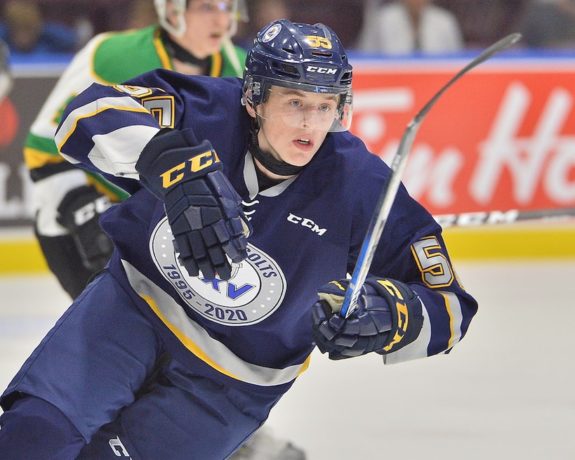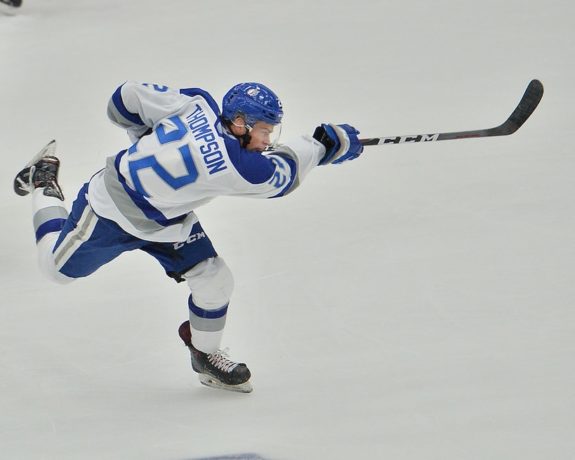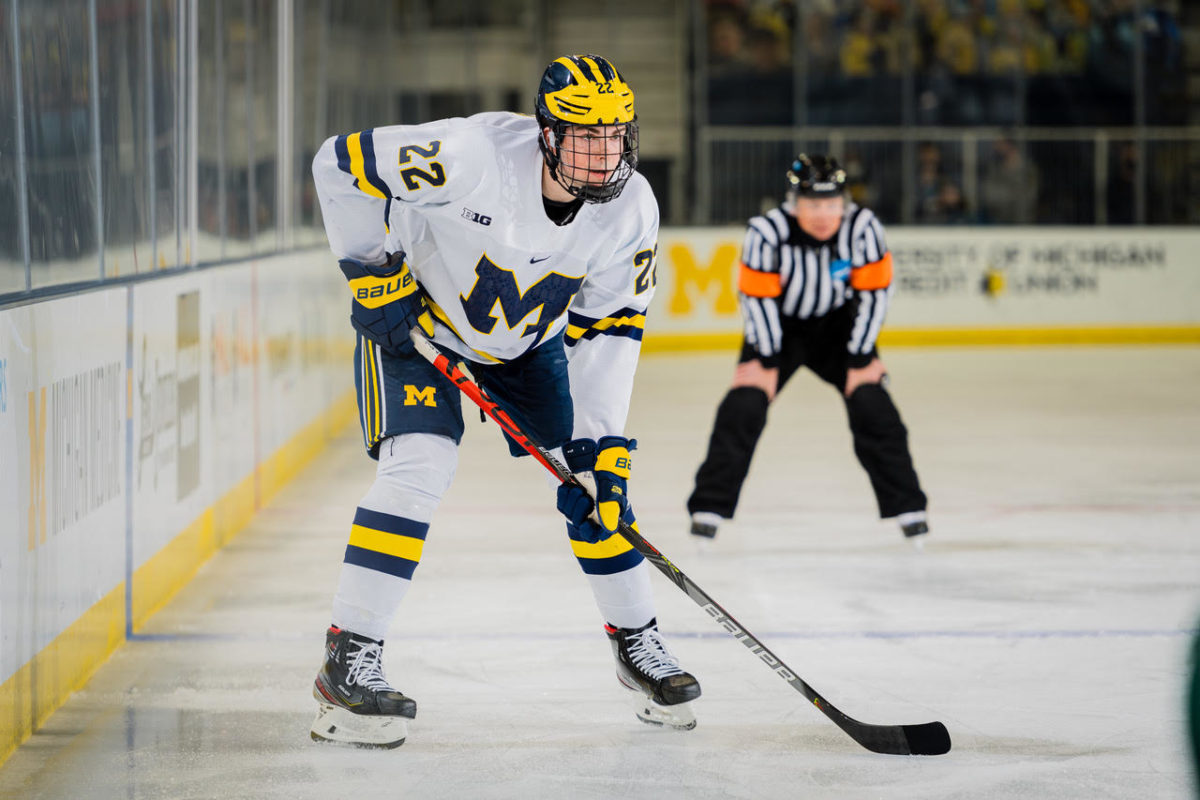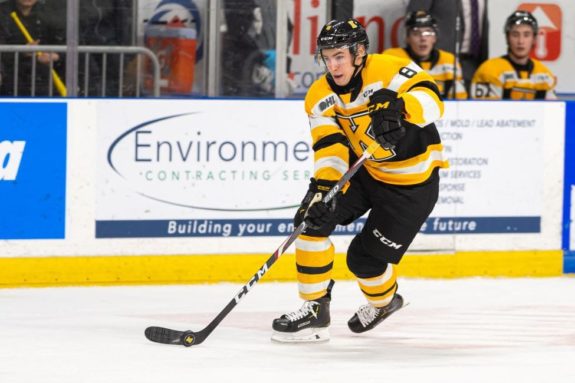For junior hockey players, one of the greatest benchmarks one can achieve is getting to represent their countries at the World Junior Championships (WJC). Scouts often warn against taking the event too seriously, or at least changing your opinion on a player because of the event; it’s a pretty small sample, after all. However, it’s a great chance for the players to gain notoriety and exposure.
Not to mention it is — in my opinion anyway — simply one of the most enjoyable events in hockey, taking place right around the holidays and signaling the beginning of the new year.
High-end prospects generally make up a majority of the rosters (especially when it comes to the “general suspects,” the Canadas, United States, Finlands, Swedens, and so on), and most frequently ones who have already been drafted by a professional team.
This makes it a great opportunity for fans to check in on their team’s recent draftees, especially being that juniors and college hockey are usually difficult to watch frequently unless you have a specific package that provides those leagues.
However, when Canada announced their camp roster on Wednesday, fans of the Los Angeles Kings were understandably looking around a little confused.
Brandt Clarke, the eighth overall pick last July and one of the highest-rated defensive prospects currently outside the NHL, was absent from the roster. Generally seen as a lock for the team’s blue line, not only will he not be going to Alberta, but he won’t even have the chance to compete for a spot in camp.
So, let’s peel back the curtain a bit and try to deduce some kind of reasoning behind Hockey Canada’s decision not to include the impressive defenseman.
Clarke Projects To Be a Star
Before we try to break down the decision, we have to begin with considering the player in question. I’m not going to go too crazy here, as plenty has already been written about him here at The Hockey Writers, and this isn’t a prospect profile; if you want to read more about Clarke, check out my colleague Zack Weiner’s breakdown.

Clarke was one of the best defenders available in the 2021 draft, mentioned right alongside other top-10 picks like Simon Edvinsson (6th to the Detroit Red Wings) and Luke Hughes (4th to the New Jersey Devils). The order of that trio really came down to personal preference to most pundits, as the trio was hardly separable in making up the next tier of blueliners available behind first overall pick Owen Power.
Clarke’s strength largely lies on the offensive side, but he is thoroughly dynamic in this aspect of the game. Currently leading Ontario Hockey League (OHL) defensemen with 23 points (five goals, 18 assists) in 18 games, he has nearly everything you want in a power-play quarterback: a heavy, accurate shot, and vision and passing ability that match up with just about anyone in Canadian major junior. He also has an uncanny ability to work defenders with his eyes, opening up passing and shooting lanes by looking off defenders or making subtle shoulder fakes. This ties into his overall hockey sense, which is revered by almost all who watch him frequently.
His skating ability is often referenced as a red flag or at least reason for hesitancy in projecting him to the next level. So many offensive defensemen in today’s NHL are elite skaters, and in that regard, Clarke falls short. He isn’t the swift-skating little guy that can get caught basically playing up as a fourth forward and still make it back to stop an odd-man rush on sheer speed should the play turn the other way. However, the 6-foot-2 defenseman’s hockey IQ usually helps balance this out, as he knows where to be and when to be there, thus compensating for a lot of those shortcomings as a pure skater. However, if he gets into a straight-up footrace, it often leads to trouble with his weak stride.
Related: Kings’ News & Rumors: Byfield, Lemieux Suspension, & Clarke Snub
Clarke has experience competing internationally for Canada, most recently at the 2021 U18s. He would put up an impressive seven points in seven games at the tournament, just one point off the team lead amongst defenders. Alongside his peers, he is simply one of the most dynamic offensive blueliners out there.
He even turned some heads in the 2021-22 preseason, causing some whispers about potentially making the Kings roster this season, but a bout with mono knocked him out of a chance to make his push. Granted, he was extremely unlikely to actually make the team, at least past the 10-game benchmark that would have used up a year of his entry-level contract. Regardless, he showed he isn’t far off from being a legitimate difference-maker in Los Angeles.
Considering Canada’s Roster
As always, Hockey Canada had an extensive list of players to choose to bring to camp, and will have a harder time yet trying to cut the roster down ahead of the tournament. The defense is no different, despite the fact that it’s shaping up to be extremely left-hand heavy. Clarke really seemed like the best option as a right-shot defenseman to many pundits and media members. If we take a look at the selection camp roster released Wednesday, only two of the 11 defensemen invited are of the right-hand variety.

One righty is Vincent Iorio, a second-round pick (in his second year of eligibility) of the Washington Capitals in 2021. He is a big (6-foot-3, 204 pounds), sound, two-way defender that has always been known more for his defensive ability that offensive dynamism. He has improved offensively this season, though, with 10 points in 17 games for the Brandon Wheat Kings of the Western Hockey League (WHL).
The other, Jack Thompson, was a third-round pick of the Tampa Bay Lightning in 2020. He currently leads his OHL team, the Sudbury Wolves, with 19 points (six goals, 13 assists) in 23 games. Thompson is known for an absolutely vicious shot and overall good offensive package. He’s also a year older than Clarke, which we’ll talk about in a minute. But if defensive inconsistencies are what’s keeping the Kings blueliner away, they should probably keep Thompson away, too.
When it comes right down to it, I find it highly unlikely that either of these players makes the roster. The only logical reason would be to keep a third pairing, defensive-specialist role for Iorio, but that seems redundant considering how many excellent defenders are likely to make the roster. And most of those guys bring more offensively, too.
The group of camp invitees is going to be loaded with star power, such as…Owen Power (didn’t do that on purpose), Carson Lambos, and Kaiden Guhle — all first-round picks with a lot of skill. Olen Zellweger, Daemon Hunt, and Donovan Sebrango are three excellent skaters and superb in both ends of the ice, each with a great chance to crack the roster themselves. Yes, Clarke probably matches up with all of those guys from a “value” standpoint, especially in the offensive end (where he arguably trumps them all), but the overall difference is pretty negligible.

I won’t break down every single defender going to camp, but you get the idea; even Ronan Seeley, one of the least-known players at camp, has merit behind an inclusion on the final roster. The seventh-round pick for Carolina is one of the better skating defensemen in all of juniors. He was drafted mostly due to his defensive play and has since exploded offensively with 21 points in 19 games this season for Everett of the WHL. In a recent segment on TSN, Bob McKenzie had him as a “lock” for Canada’s roster.
That blue line will be tough to crack, and despite Clarke’s worthiness in being a part of it as well, splitting hairs over one player likely won’t make the coaching staff feel light on the back end. They’re going to be stacked no matter what.
Further Reasoning as to Why Clarke May Not Fit
It looks like a very real possibility that Canada could be carrying all left-handed defensemen for the tournament. In November, The Athletic‘s Scott Wheeler did his annual WJC roster prediction. In it, Clarke slotted on the second pairing, and was the only right-shot on the blue line, including healthy extras (from “World junior 2022 roster projections: Scott Wheeler picks the teams and medals”, The Athletic, November 11, 2021).
While looking at all the high-end skaters, and, at least when it comes to players likely to make the roster, two-way performers, it becomes a little more believable that Clarke would fall short. There seems to be a pretty specific archetype that Hockey Canada was going for.
Ottawa 67’s head coach Dave Cameron will head up the coaching staff. He has long been known to favor more physical, defensively sound players (especially defensemen), so it could come down to a simple case of the coach’s personal preference on offensive players he’d slate ahead of Clarke, such as Lukas Cormier or even Lambos. Power will be the team’s #1 defenseman, and he’s going to see a lot of offensive starts and power-play time.
Additionally, about an hour ago, Wheeler tweeted a quote from Canada’s management group about Clarke.
Perhaps Clarke was really only in the running for a lower spot in the lineup, and Cameron wanted to go in a more defensively-focused direction in those spots. He does still have work to do at that end of the ice.
This is also alluded to in the above tweet, but Clarke is an 18-year-old. The amount of growth that goes on for players from the ages of 18-20 cannot be understated after they’ve been drafted by professional teams and given professional training regimens to work out with and prepare for the NHL. This event is largely made up of 19-year-olds most years, if for no other reason than because the 19-year-olds don’t have another opportunity to don their country’s sweaters. If it’s close between two players with the distinction of one being 18 and the other 19, most of the time, it’s going to go to the kid whose last chance it is to play. This may be why Thompson and Iorio are in camp, too, despite tough odds of making the final roster.
There is an extremely high chance that Clarke is not only part of the team a year from now but one of their biggest minute-munchers on the blue line (assuming he isn’t plying his trade in LA, that is).
World Juniors Still Well Worth a Watch
Despite the camp snub, Clarke’s future remains very bright, and Kings fans should be very excited to see him on their blue line in the next few years.
And, despite the absence of Clarke, they have extensive reason to watch the 2022 WJC, beginning Dec. 26 in Edmonton and Red Deer. This shouldn’t be surprising considering how well-represented they were in the last few years and how stacked the team’s prospect pipeline remains.

Martin Chromiak (Slovakia), Kirill Kirasanov (Russia), and Brock Faber (USA) are widely seen as locks, considering the important roles they played for their respective countries last year. Helge Grans looks like a strong candidate to crack Sweden’s blue line as a 19-year-old and likely in a featured role himself.
Kasper Simontaival and Samuel Helenius were big parts of Finland’s 2021 WJC with seven and four points, respectively, in seven games apiece and should be back. Seventh-rounder Aatu Jamsen will also push for a spot, and there is a good chance Juho Markkanen joins them as Joel Blomqvist’s backup in goal.
The WJC is one of the absolute best events in hockey, and Kings fans especially ought to have a lot of fun watching a big part of their team’s future competing.
And while the sting of his non-invite will linger for a while, hopefully for Clarke – and the Kings, too – he can use this as motivation to be the best player at the tournament in 2022, and the best he can be for his career beyond that, too.